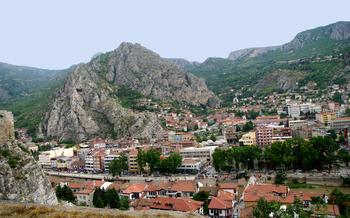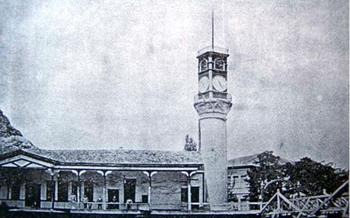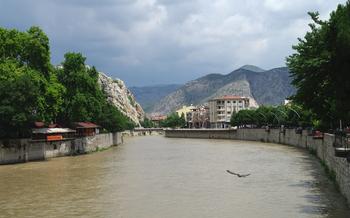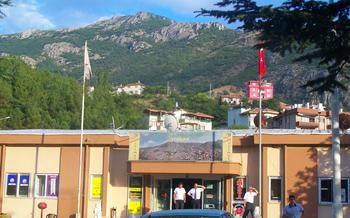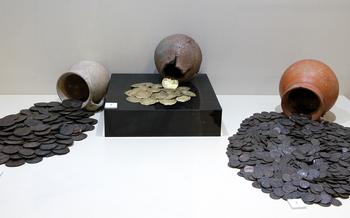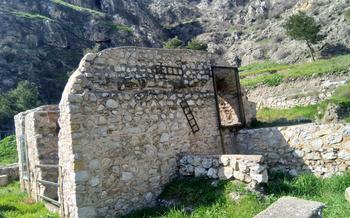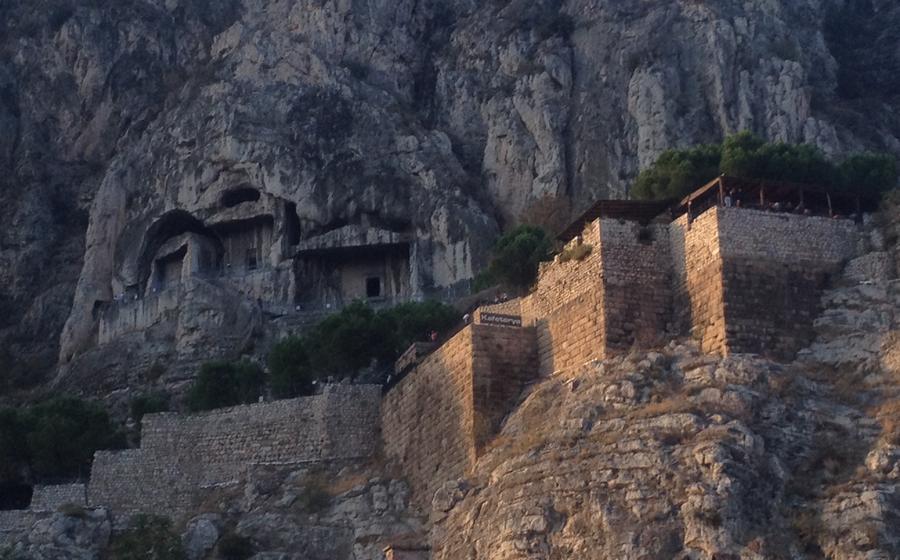
King Rock Tombs
- Historical Significance
- Architectural Features
- Location and Accessibility
- Visiting Hours and Admission Fees
- Guided Tours and Audio Guides
- Photography and Videography
- Cultural Significance and Local Traditions
- Suggested Duration of Visit
- Combining with Other Attractions
- Accessibility for Visitors with Disabilities
- Local Cuisine and Dining Options
- Souvenirs and Local Crafts
- Seasonal Considerations
- Insider Tip:
Historical Significance
Carved into the sheer cliffs overlooking the picturesque city of Amasya, the King Rock Tombs stand as a testament to the rich history and cultural heritage of the region. Dating back to the era of the Pontus Kingdom, which flourished in the 3rd century BC, these tombs bear witness to the grandeur and artistry of an ancient civilization. The Pontus Kingdom, ruled by the Mithridatic dynasty, played a significant role in the political landscape of the Hellenistic world, and its influence extended far beyond the borders of Anatolia. The King Rock Tombs, serving as the final resting places of the Pontus kings and their families, offer a glimpse into the opulence and power of this once-mighty kingdom. Moreover, the tombs are a testament to the skilled craftsmanship and artistic prowess of the ancient people, showcasing their mastery of rock-cut architecture and intricate carvings.
Architectural Features
The King Rock Tombs in Amasya, Turkey, stand as exceptional examples of ancient rock-cut architecture. These tombs, carved into the sheer rock faces of the city's iconic cliffs, showcase intricate facades and elaborate carvings that offer a glimpse into the artistic prowess and cultural beliefs of the ancient Pontus civilization.
The most striking feature of the tombs is their unique rock-cut facades. These facades are adorned with intricate carvings depicting various scenes and motifs, including mythological creatures, royal processions, and religious symbols. The craftsmanship displayed in these carvings is remarkable, with intricate details and lifelike figures that seem to leap off the rock surface.
The tombs also feature a variety of architectural elements, such as columns, pediments, and friezes, which add to their grandeur and sophistication. The columns, often adorned with intricate carvings, support the elaborate pediments, which are triangular in shape and often depict mythological scenes or royal portraits. The friezes, which run horizontally along the top of the facades, feature continuous bands of carvings, providing a narrative or decorative element to the tombs.
The symbolism and iconography depicted in the reliefs and sculptures of the King Rock Tombs offer insights into the beliefs and practices of the ancient Pontus people. The presence of mythological creatures, such as lions, griffins, and sphinxes, suggests a strong connection to the supernatural and the divine. The depiction of royal figures and processions highlights the importance of the monarchy and the ruling class in ancient Pontus. The religious symbols, such as the bull, the crescent, and the star, provide clues about the religious practices and beliefs of the ancient people.
Location and Accessibility
The King Rock Tombs are situated in the picturesque city of Amasya, Turkey, nestled amidst the stunning landscapes of the Yeşilırmak River valley. To reach the site, visitors can take advantage of the convenient public transportation options available. Regular buses and minibuses depart from the city center and make frequent stops near the tombs. For those traveling by car, detailed driving directions are easily accessible online. Once you arrive in the vicinity of the tombs, simply follow the signs that will lead you to this ancient treasure.
Visiting Hours and Admission Fees
The King Rock Tombs in Amasya, Turkey, welcome visitors throughout the week. The site is generally open to the public from 8:00 am to 5:00 pm, allowing ample time for exploration and appreciation. It is advisable to check for any seasonal variations in visiting hours, particularly during national holidays or special events.
Admission to the King Rock Tombs is subject to a nominal fee, which contributes to the preservation and maintenance of this historical treasure. Visitors can purchase tickets at the entrance of the site. Discounted rates may be available for students, senior citizens, or groups. Please inquire at the ticket counter for more information regarding admission fees and any applicable discounts.
Remember, the King Rock Tombs are a testament to the rich history and cultural heritage of the region. Respecting the site and adhering to the visiting regulations are essential to ensure its preservation for future generations.
Guided Tours and Audio Guides
Enhance your visit to the King Rock Tombs by opting for a guided tour or renting an audio guide. Led by knowledgeable local guides, these tours provide fascinating insights into the history, symbolism, and cultural significance of the tombs. Learn about the ancient Pontus Kingdom, the significance of the rock-cut facades, and the stories behind the intricate carvings and reliefs. Audio guides offer a self-guided experience, allowing you to explore the site at your own pace while listening to informative commentary. Whether you prefer a guided tour or an audio guide, these options add depth and understanding to your exploration of the King Rock Tombs.
Photography and Videography
Visitors to the King Rock Tombs are encouraged to capture the beauty and grandeur of the site through photography and videography. However, it is essential to respect the historical and cultural significance of the tombs by adhering to certain guidelines. The use of flash photography is prohibited to preserve the delicate carvings and prevent damage to the ancient artwork. Tripods and other equipment must be used cautiously to avoid obstructing the paths or impeding the movement of other visitors. Professional photography or videography for commercial purposes may require special permits or permission from the local authorities. By respecting these guidelines, visitors can document their experience while contributing to the preservation of this remarkable historical site.
Cultural Significance and Local Traditions
The King Rock Tombs hold immense cultural significance for the local community in Amasya. These ancient burial chambers are a testament to the rich history and heritage of the region, embodying the artistic achievements and cultural practices of the ancient Pontus Kingdom. Local traditions and customs associated with the tombs have been passed down through generations, contributing to the preservation of Amasya's cultural identity.
One notable tradition is the annual "Tomb Festival," a vibrant celebration held in the vicinity of the tombs. This festival showcases traditional music, dance, and local delicacies, attracting both locals and tourists alike. During the festival, the tombs are adorned with colorful decorations, and visitors can witness traditional rituals and performances that pay homage to the ancient kings and their legacy.
The local community takes great pride in the King Rock Tombs, viewing them as a symbol of their cultural heritage. Efforts are made to preserve and protect the site, ensuring its accessibility and promoting its significance to future generations. By embracing and celebrating the cultural traditions associated with the tombs, the local community plays a vital role in safeguarding Amasya's rich historical legacy.
Suggested Duration of Visit
To fully appreciate the historical significance and intricate details of the King Rock Tombs, it is recommended to allocate at least two to three hours for your visit. This duration allows you to explore the various tombs at a leisurely pace, examine the architectural features, and delve into the historical context provided by signage or a guided tour.
Depending on your level of interest in ancient history and cultural heritage, you may wish to spend more time studying the reliefs, inscriptions, and iconography that adorn the tombs. Alternatively, if you are pressed for time, you can still gain a meaningful experience by focusing on a few key tombs and their unique characteristics.
Remember that the King Rock Tombs are just one of many fascinating attractions in Amasya. If you have a limited time frame, it is important to prioritize your interests and decide how much time you want to dedicate to exploring this site in relation to other attractions in the city.
Combining with Other Attractions
A visit to the King Rock Tombs can be seamlessly combined with other captivating attractions in Amasya, offering a comprehensive exploration of the city's rich history and cultural heritage. Located just a short walk away, the Amasya Museum houses an impressive collection of artifacts, including ancient coins, pottery, and sculptures, providing a deeper insight into the region's past. The iconic Harşena Castle, perched atop a hill overlooking the city, offers panoramic views and a glimpse into Amasya's strategic importance throughout history.
For those seeking a spiritual experience, the Sultan Bayezid II Mosque, with its stunning architecture and intricate tilework, is a must-visit. Nature enthusiasts can embark on a scenic boat tour along the Yeşilırmak River, passing through picturesque canyons and lush greenery. Amasya is also renowned for its vibrant culinary scene, with traditional Turkish restaurants serving mouthwatering kebabs, gözleme, and other local delicacies.
Accessibility for Visitors with Disabilities
The King Rock Tombs are committed to ensuring accessibility and inclusivity for all visitors. Several features have been implemented to cater to individuals with disabilities. Ramps and elevators have been installed to facilitate easy access to different levels of the site. Additionally, designated parking spaces are available for visitors with mobility challenges, located conveniently close to the entrance. Visitors can request assistance from the friendly and knowledgeable staff, who are always ready to provide support and guidance throughout the visit. By prioritizing accessibility, the King Rock Tombs offer a welcoming and inclusive experience for all travelers, allowing everyone to explore and appreciate the rich history and cultural significance of this ancient site.
Local Cuisine and Dining Options
After exploring the ancient history and cultural significance of the King Rock Tombs, visitors can indulge in the culinary delights of Amasya. The city boasts a vibrant food scene with numerous restaurants and cafes serving traditional Turkish cuisine and local specialties.
For a truly authentic experience, try the local dish called "Çibörek," which consists of crispy dough filled with a flavorful mixture of minced meat, onions, and spices. Another must-try is the "Amasya kebabı," a skewer of tender lamb meat grilled to perfection and served with fresh vegetables and yogurt sauce.
When it comes to sweets, Amasya is famous for its "Elma Çöreği," a delicious pastry filled with sweet apple filling and topped with a sprinkle of powdered sugar. For a refreshing break, sip on a glass of freshly squeezed apple juice, a local specialty made from the region's renowned apples.
To fully immerse in the local culinary experience, venture into the bustling markets of Amasya. Here, visitors can find an array of fresh produce, spices, and traditional Turkish delights. Be sure to sample the local honey, known for its rich flavor and healing properties.
Souvenirs and Local Crafts
Amidst the historical allure of the King Rock Tombs, visitors can delve into the vibrant local crafts and souvenirs that capture the essence of Amasya's rich cultural heritage. Quaint shops and bustling markets offer an array of unique treasures for travelers to cherish as mementos of their journey.
From intricate pottery adorned with traditional motifs to handwoven carpets showcasing vibrant designs, the local crafts of Amasya reflect the skill and artistry of the region's artisans. Visitors can find authentic souvenirs inspired by the King Rock Tombs, such as miniature replicas of the rock-cut facades or jewelry incorporating motifs from the ancient reliefs.
Exploring the local markets is an immersive experience, where visitors can interact with friendly vendors and discover hidden gems. Bargaining is a customary practice, allowing travelers to engage with the locals and secure the best prices for their desired souvenirs.
In addition to tangible souvenirs, visitors can indulge in the culinary delights of Amasya. Local delicacies such as "keşkek," a hearty dish made from wheat, meat, and yogurt, or "Amasya çöreği," a sweet pastry filled with walnuts, offer a taste of the region's culinary traditions.
Shopping for souvenirs and savoring local cuisine are integral parts of any travel experience, and in Amasya, these activities provide a deeper connection to the city's history and culture. Visitors can take home not just physical souvenirs but also lasting memories of the warmth and hospitality of the local people.
Seasonal Considerations
When planning a visit to the King Rock Tombs, it is important to consider seasonal factors to ensure a pleasant and fulfilling experience. The best time to visit Amasya and the tombs is during the shoulder seasons, which fall between April and May and September and October. During these months, the weather is typically mild and comfortable, with warm days and cool nights. The crowds are also smaller compared to the peak summer season, allowing for a more leisurely exploration of the site.
Summer in Amasya can be hot and dry, with temperatures reaching the high 30s Celsius (100s Fahrenheit). While the tombs offer some shade, it is advisable to visit early in the morning or late in the afternoon to avoid the intense midday heat. Visitors should also bring plenty of water and wear lightweight, breathable clothing.
Winter in Amasya can be cold and snowy, with temperatures dropping below freezing. The tombs may be partially covered in snow during this time, but they remain accessible to visitors. It is essential to dress warmly and wear appropriate footwear for snowy conditions.
Visitors should also be aware of special events or festivals that may take place in Amasya during their visit. The annual Amasya International Art and Culture Festival, held in July, showcases local art, music, and performances and attracts a large number of visitors. The festival offers a vibrant and lively atmosphere, but it can also lead to increased crowds at the King Rock Tombs and other popular attractions.
Insider Tip:
For an unforgettable experience, plan your visit to the King Rock Tombs during the golden hour, just before sunset. The warm, diffused light casts a magical glow on the rock-cut facades, enhancing the intricate details and carvings. As the sun dips below the horizon, the tombs transform into a canvas of shadows and silhouettes, creating a breathtaking spectacle. Remember to bring your camera to capture the ethereal beauty of the site during this special time of day.

